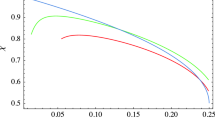Abstract
Asymptotic relationships between a class of continuous partial differential equation population models and a class of discrete matrix equations are derived for iteroparous populations. First, the governing equations are presented for the dynamics of an individual with juvenile and adult life stages. The organisms reproduce after maturation, as determined by the juvenile period, and at specific equidistant ages, which are determined by the iteroparous reproductive period. A discrete population matrix model is constructed that utilizes the reproductive information and a density-dependent mortality function. Mortality in the period between two reproductive events is assumed to be a continuous process where the death rate for the adults is a function of the number of adults and environmental conditions. The asymptotic dynamic behaviour of the discrete population model is related to the steady-state solution of the continuous-time formulation. Conclusions include that there can be a lack of convergence to the steady-state age distribution in discrete event reproduction models. The iteroparous vital ratio (the ratio between the maximal age and the reproductive period) is fundamental to determining this convergence. When the vital ratio is rational, an equivalent discrete-time model for the population can be derived whose asymptotic dynamics are periodic and when there are a finite number of founder cohorts, the number of cohorts remains finite. When the ratio is an irrational number, effectively there is convergence to the steady-state age distribution. With a finite number of founder cohorts, the number of cohorts becomes countably infinite. The matrix model is useful to clarify numerical results for population models with continuous densities as well as delta measure age distribution. The applicability in ecotoxicology of the population matrix model formulation for iteroparous populations is discussed.
Similar content being viewed by others
References
Calow, P., R. M. Silby and V. Forbes (1997). Risk assessment on the basis of simplified life-history scenarios. Environ. Toxicol. Chem. 16, 1983–1989.
Caswell, H. (1989). Matrix Population Models, Sunderland, MA: Sinauer Associates Inc.
Cushing, J. M. (1998). An Introduction to Structured Population Dynamics, Vol. 71, Philadelphia: Society for Industrial and Applied Mathematics.
de Roos, A. M. (1997). A gentle introduction to physiologically structured population models, in Structured-population Models in Marine, Terrestrial, and Freshwater Systems, S. Tuljapurkar and H. Caswell (Eds), New York: Chapman & Hall, pp. 119–204.
de Roos, A. M., O. Diekmann and J. A. J. Metz (1992). Studying the dynamics of structured population models: a versatile technique and its application to Daphnia. Am. Nat. 139, 123–147.
Funasaki, E. (1997). Examination of dynamical behaviour and estimation of toxicant levels in chemically stressed population models, PhD thesis, University of Tennessee.
Gantmacher, F. R. (1977). The Theory of Matrices, New York: Chelsea.
Guckenheimer, J. and P. Holmes (1985). Nonlinear Oscillations, Dynamical Systems and Bifurcations of Vector Fields, 2nd edn, Applied Mathematical Sciences 42, New York: Springer-Verlag.
Gyllenberg, M., I. Hanski and T. Lindström (1997). Continuous versus discrete single species population models with adjustable reproductive strategies. Bull. Math. Biol. 59, 679–705.
Hallam, T. G., R. R. Lassiter, J. Li and W. McKinney (1990a). Toxicant-induced mortality in models of Daphnia populations. Environ. Toxicol. Chem. 9, 597–621.
Hallam, T. G., R. R. Lassiter, J. Li and L. A. Suarez (1990b). Modelling individuals employing an integrated energy response: application to Daphnia. Ecology 71, 938–954.
Huyer, W. (1997). On periodic cohort solutions of a size-structured population model. J. Math. Biol. 35, 908–934.
Jenkins, G. M. and D. G. Watts (1968). Spectral Analysis and its Applications, San Francisco: Holden-Day Inc.
Kendall, B. E., C. J. Briggs, W. W. Murdoch, P. Turchin, S. P. Ellner, E. McCauley, R. M. Nisbet and S. N. Wood (1999). Why do populations cycle? A synthesis of statistical and mechanistic modeling approaches. Ecology 80, 1789–1805.
Koh, H. L., T. G. Hallam and H. L. Lee (1997). Combined effects of environmental and chemical stressors on a model Daphnia population. Ecol. Modelling 103, 19–32.
Kooi, B. W. and M. P. Boer (1995). Discrete and continuous time population models, a comparison concerning proliferation by fission. J. Biol. Syst. 3, 543–558.
Leslie, P. H. (1945). On the use of matrices in certain population mathematics. Biometrika 33, 183–212.
Liu, L. and J. E. Cohen (1987). Equilibrium and local stability in a logistic matrix model for age-structured populations. J. Math. Biol. 25, 73–88.
Metz, J. A. J. and O. Diekmann (1986). The Dynamics of Physiologically Structured Populations, Lecture Notes in Biomathematics 68, Berlin: Springer-Verlag.
Olsen, L. F. and W. M. Schaffer (1990). Chaos versus noisy periodicity: alternative hypothesis for childhood epidemics. Science 249, 499–504.
Silva, J. A. L. and T. G. Hallam (1992). Compensation and stability of nonlinear matrix models. Math. Biosci. 101, 67–101.
Silva, J. A. L. and T. G. Hallam (1993). Effects of delay, truncations and density dependence in reproduction schedules on stability of nonlinear Leslie matrix models. J. Math. Biol. 31, 367–395.
Takens, F. (1981). Detecting strange attractors in turbulence, in Dynamical Systems and Turbulence, D. A. Rand and L. S. Young (Eds), New York: Springer-Verlag.
Author information
Authors and Affiliations
Corresponding author
Rights and permissions
About this article
Cite this article
Kooi, B.W., Hallam, T.G., Kelpin, F.D.L. et al. Iteroparous reproduction strategies and population dynamics. Bull. Math. Biol. 63, 769–794 (2001). https://doi.org/10.1006/bulm.2001.0246
Received:
Accepted:
Issue Date:
DOI: https://doi.org/10.1006/bulm.2001.0246




